For our final Suki Says post we are excerpting the introduction to her section on jumps. Jump combinations are usually the last portion of ballet class so it seemed only fitting this section should close out this series. Ms. Schorer opens this chapter with the story of how she came to be a dancer at the New York City Ballet and her first meeting with George Balanchine. Mr. B saw her execution of a fast entrechat quatre combination while taking class at SAB during a visit to New York and she ended up with a contract! Ms. Schorer writes about how that entrechat quatre combination was “the turning point of my life.” So, you never know where a strong jump may take you!
Read on for an excerpt that goes over the general principles needed for any jump and consult the full text for more detailed descriptions of the five specific categories of jumps explained in the book.

Mr. Balanchine said that a dancer should descend from a jump like a mother bird landing on her eggs. Like many of his sayings, this one includes a couple of essential ideas. First, she knows where she will alight. And she controls her weight as she lands, softly. The dancer catches herself on the tips of her toes; since the feet are fully pointed in the air, the toes touch the floor first. She does not drop to the ball of the foot, and/ or fall down to the full foot; rather, she goes through the foot as the ankle releases and the knee bends over the toes.
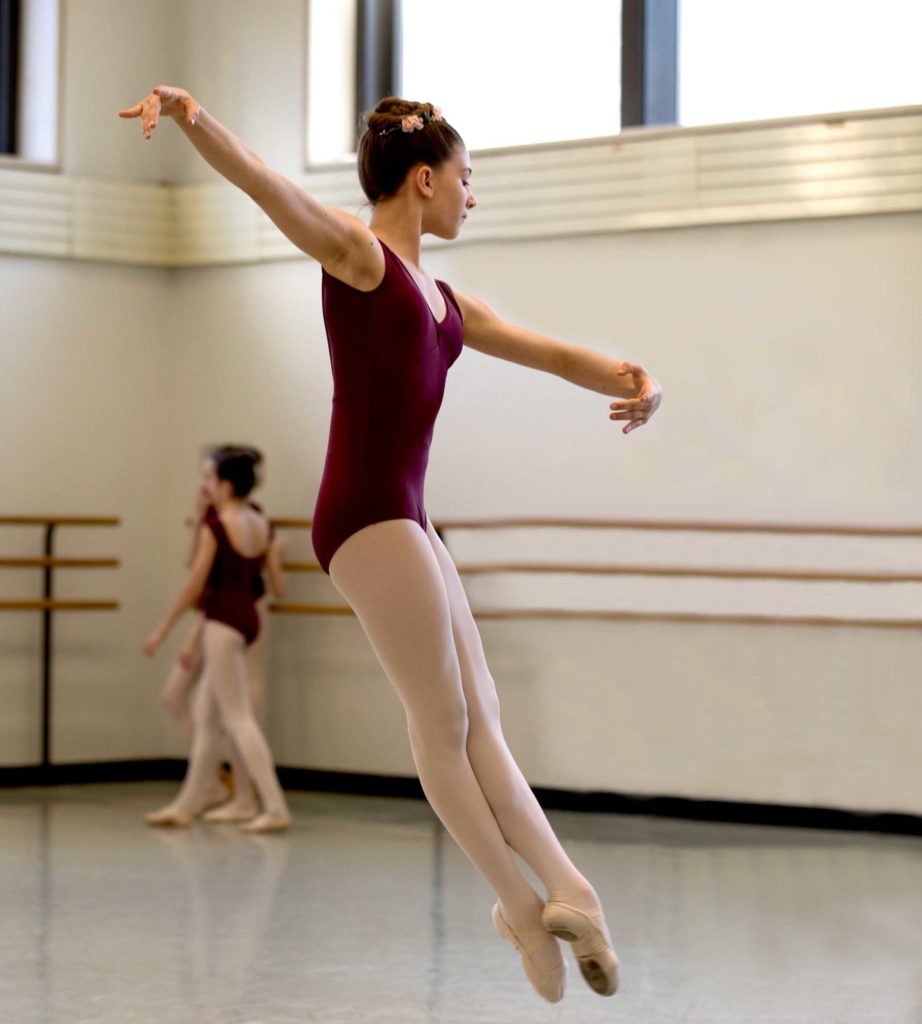
“It is not keeping the heel off the floor. It is avoiding landing at once on your heel. You control your descent and maybe you touch your heel afterward, not first. You delay the heel, develop the strength to hold yourself. Dancers immediately put the whole foot down because of a very weak ankle.”
The plié should be continuous, without pauses, stops, or jerks, and the plié after the jump is usually as deep as the plié before. On landing, the plié serves as the dancer’s shock absorber. If the force in the landing from the jump is properly absorbed there should be only a muffled “taaah” on contact with the floor, certainly no percussive knock or bang. The weight is controlled over the ball of the foot by the placement of the hips and torso as well as by the muscles of the foot, calf, and especially the thigh; turnout is maintained, and the heel does not slip back. The plié can be thought of as a recovery from the jump, especially if it is the last jump in the combination. “Plié is not a stretch,” Mr. B said, “it is a recovery.”
…How the heel will touch the floor in landing depends on the exercise and on how the dancer is built – in particular, on the length of her Achilles tendon. At the end of a combination, the heels generally do go down and touch the floor lightly as the dancer straightens her legs, but they will not hit the floor. “The heel is like a brake; it stops the movement,” Mr. B liked to say. In a series of jumps, the completion of one landing flows seamlessly, without even a pause, into the beginning of the next ascent. The plié is itself continuous, and the heel can, or can seem to, press into the foor. However, this is a smooth, controlled action, not at all the same as banging down, letting the weight settle back in landing, or stopping the movement. “The heel is toward the floor, but it cannot rest on the foor. When you rest, you are finished. It is the end of the action.” If the exercise is very fast, there is no time and no need to put the heel down. If the exercise is very slow and the dancer lands on two feet, she sometimes goes into a plié that is lower than a demi-plié, more like a three-quarter plié, and consequently doesn’t put her heels down…
One kind of special exercise that Mr. B liked to give was any relatively simple jump that lands on two feet at a slow tempo. The plié was deep and long to help us develop greater strength and control. The strength and the energy we gathered in the plié made possible a more powerful launch into the next step. In class he sometimes summed up the kind of plié that emphasizes gathering or collecting power by saying, “Collect your dirty laundry off the floor!” Landings onto one foot from big jumps followed by slow, deep pliés are very difficult to control and require a great deal of strength; extra practice of this kind made us better prepared for them….
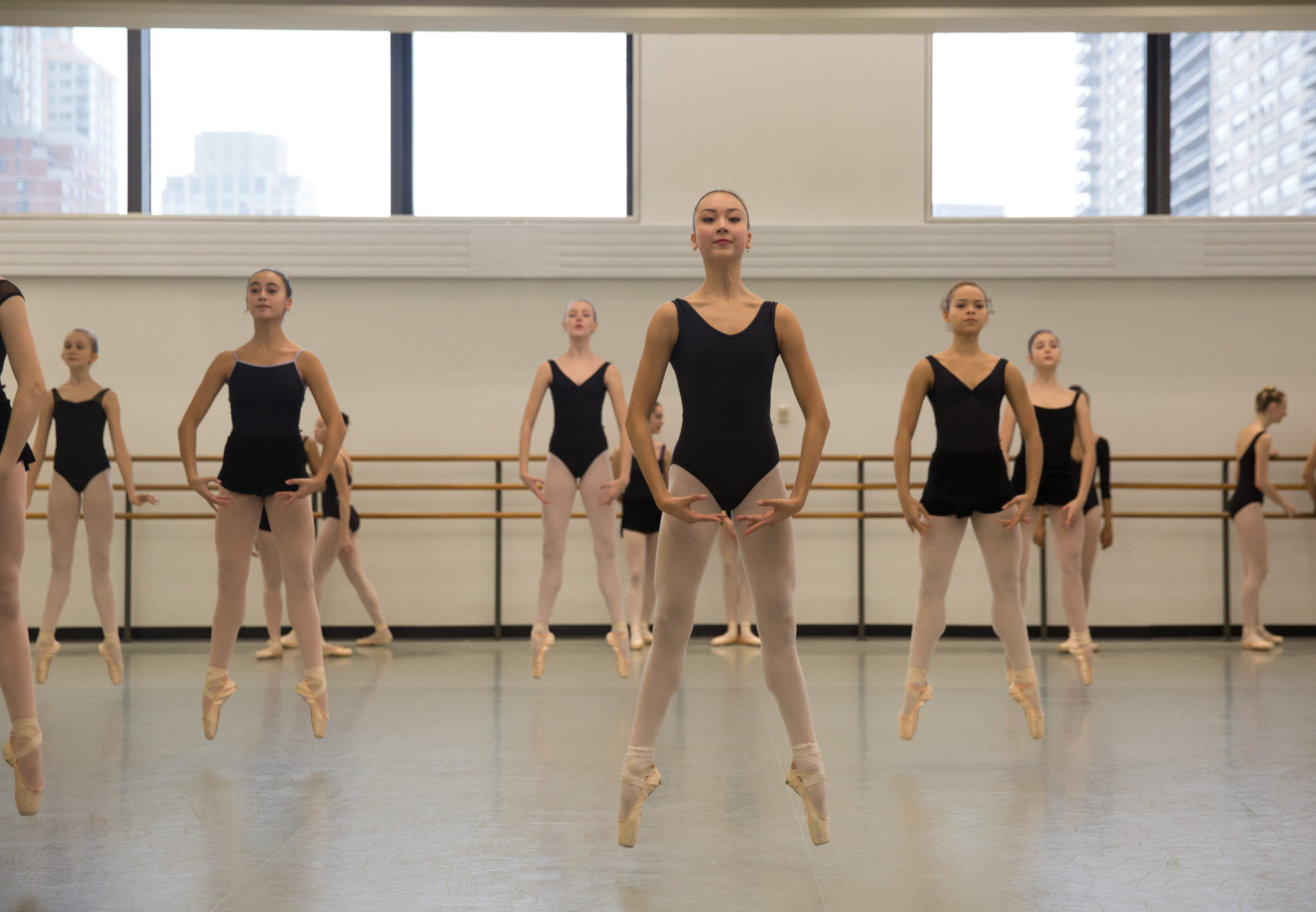
Mr. B often included exercises specifically for the head, arms, and upper body, but we were expected to apply the finesse we developed in them to all the rest of the class, including jumps, and, of course, when dancing his ballets. Sometimes, dancers trying to increase the height of the jump unintentionally throw the arms out stiffly and heave the torso backward. When he saw this, Mr. B would say, “No! We need just the reverse,” and set a jumping exercise calling for the dancer to maintain the arms in fifth low while jumping. This eliminates the boost that some mistakenly think comes from flailing arms, it helps to stabilize the torso forward, and it focuses the dancer’s attention on the feet, legs, and hips, on doing a good plié. Once he saw us actively using the power of the plié and keeping the weight forward in the jump, Mr. B might repeat the exercise, asking us for coordinated, active, and attractive arms, and it felt suddenly much easier. “We use the arms for beauty and for help. It can be twice as easy with two arms.”
In many schools, arms are “put out to the side,” more or less in second position, for an entire jump combination. They’re hung out like the laundry and forgotten. This can make for bad habits, such as lack of épaulement and stiff, jerky, or uncoordinated arms. For this reason Mr. B often said, “If you don’t know what to do with the arms, put them down.” It can be enough to have the dancers use only the appropriate changes in épaulement, rather than practice incorrectly with the arms stuck stiffly out “like a scarecrow” (see page 294).
In batterie he wanted to see and hear crisp, clear beats from men and women: both legs beating, thighs active, calves striking, feet crossing. In addition to the combinations in the center, he gave us jumping exercises with the support of the barre (e.g., entrechat six, cabriole) to help us develop the necessary skill and finesse.
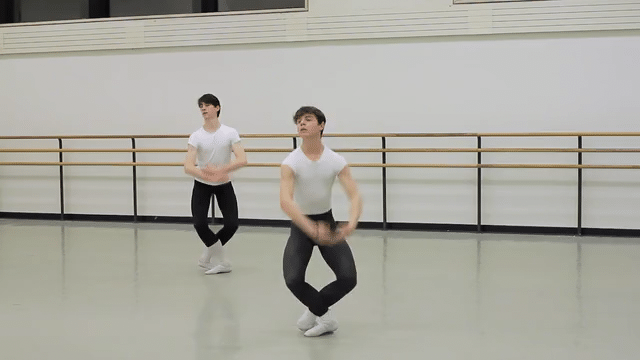
Many of the Balanchine ballets include passages requiring unusual speed. Mr. B helped us prepare for that kind of dancing by giving jumping exercises at very fast tempos. In this kind of exercise (e.g., changements, échappés sautés) the plié becomes shallower and at extreme speeds may even disappear completely. Even though dancers generally think of controlling their landings with generous pliés using the thighs and going through the feet, in these fast tempo exercises it is the toes, feet, and calves that work the most. The heels rarely touch the floor, and when they do, it is barely, the lightest touch possible. The knees still go out over the toes, but not as far, because the plié is not nearly as deep. Dancers work to develop the skill of pointing instantly when pushing sharply off the foor.
Mr. B had a special liking for jumps in which the dancer “makes a picture” – that is, jumps that called for the dancer to establish a line instantly in the air and hold it. Nothing moving until the last possible moment before landing. One result was that the audience saw the designated shape much more clearly, because it was held longer. Her dancing is once again more articulate. The power, skill, and control, mainly with the feet, legs, and arms, necessary to make and hold any picture is developed at the barre and in other center work but finds some of its most important use in doing jumps. The ballet dancer is partly a creature of the air.
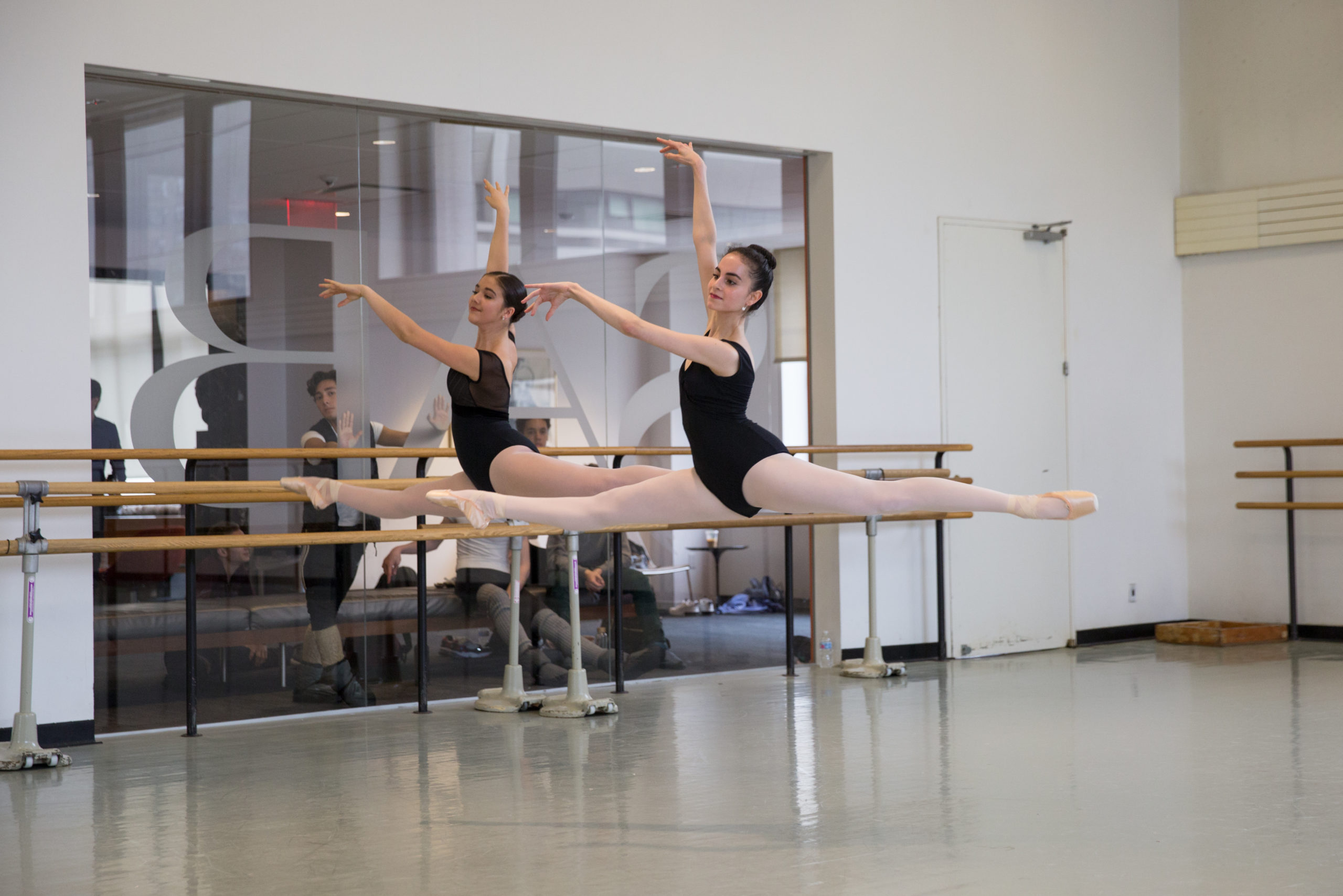
Of all the aspects of control Mr. B wanted the dancer to have, maybe the most ambitious was the ability to defy gravity. Mr. B wanted us to try to stay in the air. He would say to us, “Force gravity!” That’s not literally possible, but the dancer can work to achieve the illusion. That illusion is the other result of being able to freeze a position in the air. She looks like she is suspended in the air a long time. And then Balanchine wanted us to take ourselves down to the floor. We, not the force of gravity, were to decide when we would land. Again, this was not literally possible, but we worked to create the illusion. To further improve our ability to show him a clear, long-lasting “picture” that stayed in the air, we practiced simple jumps such as échappé, sauté, assemblé, soubresaut, and Cecchetti changements with this goal clearly in mind.
Creating that illusion wasn’t quite enough. When the tempo slowed, he had one measure for staying in the air that was quite definite. He wanted us to stay in the air for the same length of time we were in plié. This soon becomes impossible, but as usual, seeing maximum energy expended in trying was his immediate goal.
Remember, “The effort comes first, the result comes later.”
He wanted us to really jump, to get well off the floor, to soar, and he knew that uncommonly good pliés were necessary. So he set lots of slow jumping combinations that let us cultivate slow landings on two feet and on one foot, starting with the tips of our toes, almost grasping the floor with them, going through the feet, lowering into deep, long pliés with full use of the thighs, weight controlled over the balls of the feet without the heels falling to the floor or the weight settling back, the dancer ready to push off again. Mr. B observed that often, even when the music allows them to plié fully, dancers tend to cut the plié short. “Don’t be stingy with plié,” Mr. B said, “make it big, make it juicy.” His dancing was full of generosity of spirit that starts to show itself in this big, “juicy” plié. As our pliés improved, they provided the power for the long-lasting jumps he wanted to see.
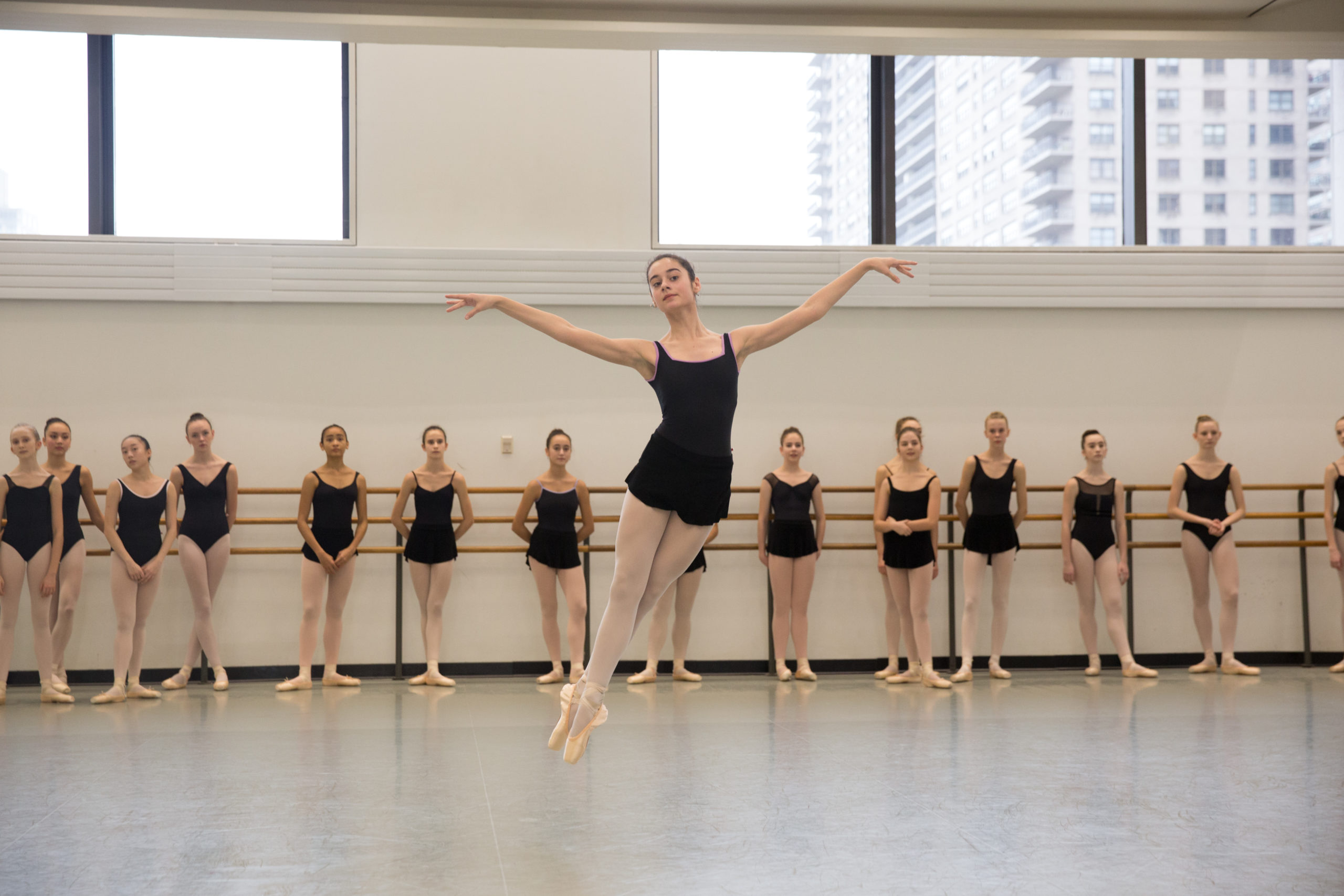
As the dancer’s plié gets more powerful and she grows stronger, she has more time in the air. When she also feels more in control of the picture her body makes in the air, her confidence in her ability to create and sustain the illusion of indefinite suspension in the air grows. She can dance as if she is quite at home in the air, deciding how long to stay up and when to land. That adds to the illusion. Sometimes Mr. B made us believe that we could do the impossible. Sometimes we danced and made the audience believe they had seen the impossible.
|
Essential Details in any Jump
Do not bounce out of plié; instead, plié and push off the floor, taking your body into the air
(change levels); the plié never stops
Point the feet rapidly, including the tips of the toes
On landing, the tips of the toes touch the floor first; go through the feet under control; don’t fall
onto the full foot
Bring or place the second foot to the floor in steps such as glissade and sissonne faillie, toes first
and heel somewhat forward but not necessarily down
Coordinate the movement of the arms with the jump
Control the torso throughout the jump; no heaving
|
(Schorer, 1999, p.290-294)
Schorer, S., Lee, C. R., & Rosegg, C. (1999). Suki Schorer on Balanchine Technique. A.A. Knopf.








